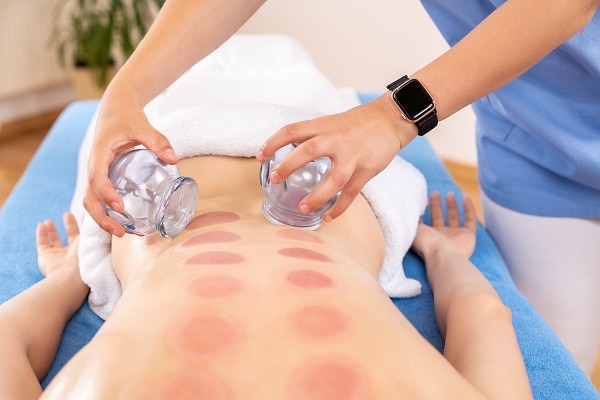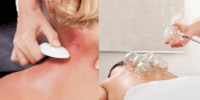Cupping Therapy: Exploring The Different Cupping Methods And Benefits

Cupping therapy, an ancient practice that has gained popularity in recent years, involves the use of cups to create suction on the skin. This therapy is believed to promote healing and relieve various health conditions.
In this article, we will explore the different cupping methods and their respective benefits.
Traditional Chinese Cupping is the most well-known method, which involves the use of glass or bamboo cups and a flame to create suction. Fire Cupping, a variation of traditional cupping, uses alcohol-soaked cotton balls set ablaze to create suction. Wet Cupping, on the other hand, involves making small incisions on the skin before applying the cups, allowing for the extraction of a small amount of blood.
Dry Cupping, another popular method, does not involve any incisions and is mainly used for pain relief and relaxation. Silicone Cupping, a modern approach, uses silicone cups instead of glass or bamboo. Facial Cupping, a specialized technique, is used for facial rejuvenation and promoting healthy skin.
By understanding the different cupping methods and their benefits, individuals can make informed decisions about incorporating this therapy into their wellness routine.
Traditional Chinese Cupping
Traditional Chinese cupping is a therapeutic technique that involves placing cups on the skin and creating a vacuum to stimulate blood flow and promote healing. This method has been used for thousands of years in traditional Chinese medicine to treat various ailments and improve overall well-being.
The cups used in Traditional Chinese cupping are typically made of glass or bamboo and come in different sizes. The practitioner heats the cups with a flame and then places them on specific areas of the body, creating suction as the air inside the cup cools. This suction creates a negative pressure that helps to increase blood circulation, loosen muscles, and release toxins.
Traditional Chinese cupping is believed to balance the body’s energy flow and restore harmony, providing a holistic approach to health and wellness.
Fire Cupping
Fire cupping, a popular modality within the field of cupping, involves the use of heat to create a vacuum within glass cups, which are then placed on the skin to stimulate blood flow and promote healing.
The process begins by soaking a cotton ball in a flammable substance, such as alcohol, and igniting it. This flaming cotton ball is then quickly inserted into the cup, heating the air inside and creating a vacuum.
The cup is immediately placed on the skin, where it adheres due to the suction. As the cup cools, a therapeutic effect is achieved as blood vessels dilate, allowing for increased circulation and oxygenation of tissues.
Fire cupping is believed to reduce inflammation, alleviate pain, and promote relaxation. However, due to the potential for burns and other risks associated with fire cupping, it is important for practitioners to have proper training and adhere to safety precautions.
Wet Cupping
Wet cupping, also known as bloodletting cupping, involves the use of small incisions in the skin to release a small amount of blood before applying the cups, which are then left in place for a specific duration of time.
This method is believed to promote the removal of toxins from the body and improve blood circulation.
The incisions are made using a sterile lancet and are typically very small, resulting in minimal pain and scarring.
After the cups are removed, the practitioner may apply antibiotic ointment or bandages to the incision sites to prevent infection.
Wet cupping is often used as a form of traditional medicine in certain cultures and is believed to have therapeutic benefits, although more research is needed to fully understand its mechanisms and efficacy.
Dry Cupping
Dry cupping is a popular alternative medicine technique that involves placing cups on the skin to create a suction effect, stimulating blood flow and promoting relaxation.
Unlike wet cupping, dry cupping does not involve making incisions on the skin or drawing blood.
The cups used in dry cupping are typically made of glass, plastic, or silicone, and are placed on specific areas of the body.
The suction created by the cups helps to improve circulation, reduce muscle tension, and alleviate pain.
Dry cupping is believed to have various benefits, including the ability to promote detoxification, improve the immune system, and enhance overall well-being.
While there is limited scientific evidence to support these claims, many individuals find dry cupping to be a soothing and therapeutic practice.
Silicone Cupping
Silicone cupping, a contemporary variation of cupping therapy, involves the use of cups made from silicone material to create a suction effect on the skin, promoting various potential therapeutic effects.
Silicone cups are flexible and can be easily squeezed to create a vacuum, which allows for precise control of the suction strength and application.
The cups are placed on specific areas of the body, creating a vacuum seal that pulls the skin and underlying tissues upwards. This suction effect is believed to increase blood circulation, stimulate the lymphatic system, and promote the release of toxins from the body.
Additionally, silicone cupping is thought to help relax muscles, reduce pain and inflammation, and improve overall well-being.
As a non-invasive and relatively safe therapy, silicone cupping has gained popularity as an alternative treatment option for various health conditions.
Facial Cupping
Facial cupping, a technique gaining popularity in the realm of aesthetics, involves the application of small cups to the face to create a vacuum seal, potentially enhancing blood circulation and promoting a youthful appearance. This method is believed to stimulate collagen production, reduce puffiness, and improve skin tone and texture. Advocates claim that facial cupping can also alleviate tension in facial muscles, reduce the appearance of fine lines and wrinkles, and detoxify the skin by increasing lymphatic drainage. However, scientific evidence supporting these claims is limited, and further research is needed to determine the true benefits of facial cupping. As with any alternative therapy, it is important to consult with a qualified professional before trying facial cupping to ensure safety and effectiveness.
| Pros | Cons | Neutral | ||||
|---|---|---|---|---|---|---|
| Potential youthfulness | Limited scientific evidence | Individual experiences may vary | ||||
| Improved blood circulation | Lack of research on long-term effects | Relatively low risk of side effects | ||||
| Potential reduction of fine lines and wrinkles | Need for professional guidance | May not be suitable for all skin types | May provide temporary improvement in skin texture and tone | Limited information on its impact on collagen production and elasticity | Potential for skin sensitivity or irritation |
Cupping for Relaxation
One intriguing aspect of cupping for relaxation is its potential to induce a state of calmness and alleviate stress by stimulating the body’s natural relaxation response.
Cupping therapy involves the use of suction cups placed on different parts of the body, creating a vacuum-like effect. The cups create a negative pressure that draws blood flow to the surface of the skin, promoting circulation and releasing tension. This process activates the parasympathetic nervous system, which is responsible for the body’s relaxation response.
Scientific studies have shown that cupping therapy can significantly reduce levels of stress hormones, such as cortisol, and increase the production of endorphins, which are the body’s natural painkillers and mood enhancers.
Additionally, cupping for relaxation has been reported to improve sleep quality and overall well-being.
Cupping for Pain Relief
This discussion focuses on the use of cupping therapy for pain relief. Cupping has been found to alleviate pain by improving blood circulation and promoting the release of endorphins, which are natural painkillers.
Additionally, cupping can be targeted to specific areas of pain, such as the back or shoulders, to provide localized relief.
Combining cupping with other therapies, such as acupuncture or massage, may further enhance the pain-relieving effects.
How Cupping Alleviates Pain
Cupping therapy has been found to effectively alleviate pain, providing a non-invasive treatment option for individuals seeking relief. The mechanism by which cupping alleviates pain is not fully understood, but several theories have been proposed.
One theory suggests that cupping stimulates the release of endorphins, which are natural painkillers produced by the body. Another theory suggests that cupping improves blood circulation and lymphatic flow, thereby reducing inflammation and promoting healing. Additionally, cupping may also stimulate the nervous system, altering the perception of pain.
The suction created by the cups may help to release tight muscles and fascia, reducing muscular tension and pain. While more research is needed to fully understand the mechanisms behind cupping’s pain-relieving effects, its efficacy in providing pain relief has been reported in various studies and anecdotal evidence.
Target Areas for Pain Relief
To effectively target areas for pain relief, it is important to identify specific trigger points or areas of discomfort in the body. Cupping therapy offers a unique approach in addressing these areas by creating suction on the skin, which helps increase blood flow and promote healing.
The cupping technique can be applied to various body parts, depending on the location of pain. For example, for back pain, cups can be placed along the spine or on specific muscle groups. Alternatively, for joint pain, cups can be applied directly over the affected joint. Cupping can also be used to target specific trigger points, such as knots or tight muscles, by placing the cups directly over these areas.
By targeting specific areas of pain, cupping therapy provides a targeted approach to pain relief.
Combining Cupping with Other Therapies
By integrating cupping therapy with other complementary treatments, it is possible to enhance the overall effectiveness of pain management strategies. Cupping therapy can be combined with various therapies such as acupuncture, massage, and herbal medicine to provide a holistic approach to pain relief. Acupuncture can help stimulate specific points in the body, while cupping therapy can enhance blood flow and promote healing. Massage can further relax muscles and reduce tension, while cupping therapy can help release toxins and improve circulation. Herbal medicine can be used in conjunction with cupping therapy to address underlying imbalances and support the body’s healing process. By combining cupping therapy with these complementary treatments, individuals can experience a synergistic effect that maximizes pain relief and promotes overall well-being.
| Therapy | Benefits | |||
|---|---|---|---|---|
| Acupuncture | Stimulates specific points in the body | |||
| Massage | Relaxes muscles and reduces tension | |||
| Cupping | Enhances blood flow and promotes healing | |||
| Herbal medicine | Addresses underlying imbalances and supports healing process | Meditation | Calms the mind and promotes overall well-being |
Frequently Asked Questions
Are there any potential side effects or risks associated with cupping therapy?
Potential side effects of cupping therapy include skin irritation, bruising, and discomfort during the procedure. In rare cases, more serious complications such as burns, infection, or nerve damage may occur. It is important to seek professional advice before undergoing cupping therapy.
How long do the effects of cupping therapy typically last?
The effects of cupping therapy typically last for a few days to a week. However, the duration may vary depending on factors such as the individual’s condition, the type of cupping used, and the frequency of treatment.
Can cupping therapy help with conditions such as anxiety or depression?
Cupping therapy has been suggested as a potential treatment for anxiety and depression, although further research is needed to determine its effectiveness. Studies have shown mixed results, indicating the need for more rigorous investigations.
Is cupping therapy suitable for everyone, including pregnant women or individuals with certain medical conditions?
Cupping therapy is not suitable for everyone. Pregnant women should avoid it, as well as individuals with certain medical conditions such as bleeding disorders, skin infections, or open wounds. It is important to consult with a healthcare professional before considering cupping therapy.
Are there any specific guidelines or precautions to follow before, during, or after a cupping therapy session?
Specific guidelines and precautions should be followed before, during, and after a cupping therapy session. These measures ensure the safety and effectiveness of the treatment, particularly for pregnant women or individuals with certain medical conditions.









